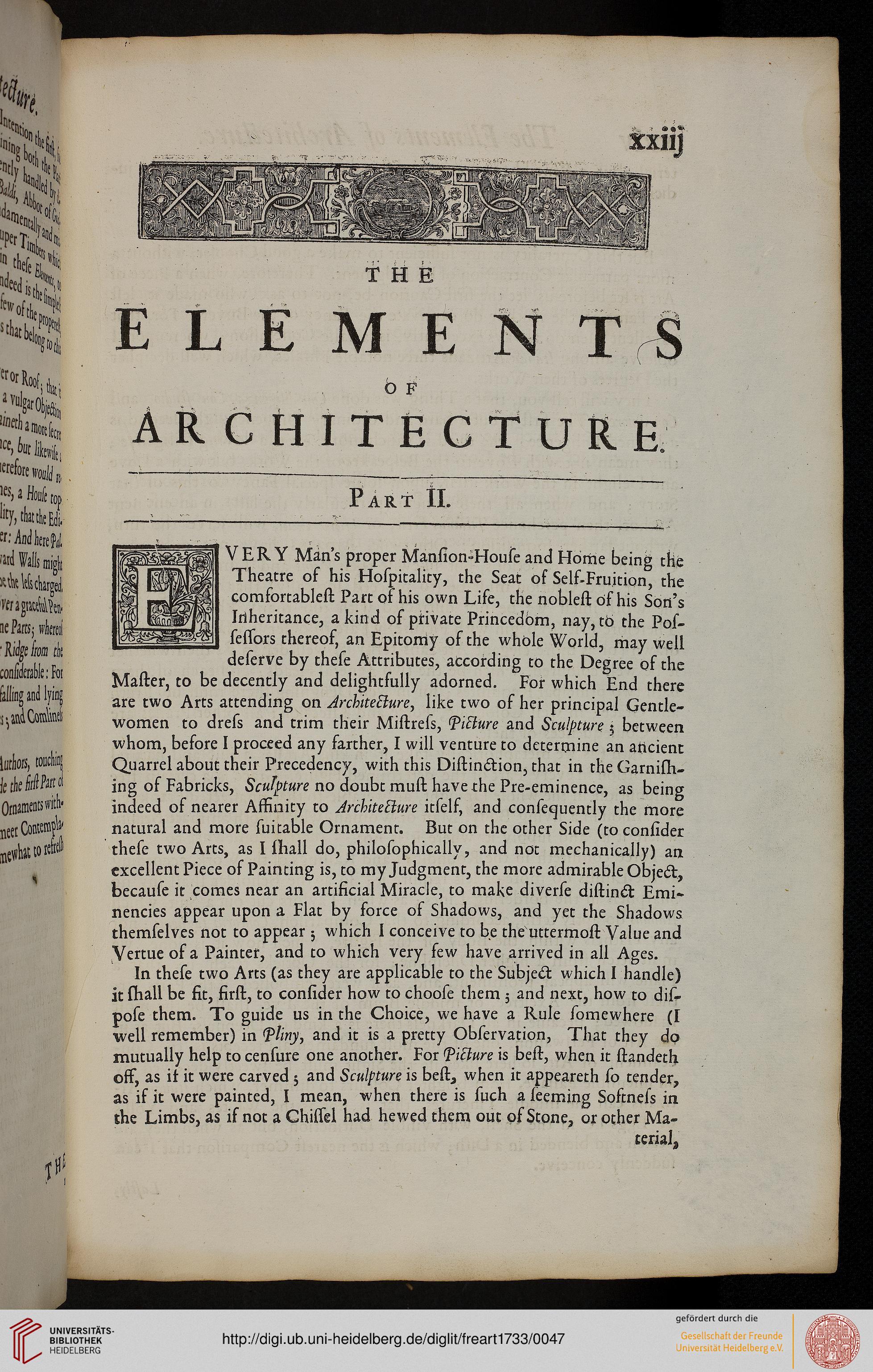XX11J
THE
E L E M E N T S
6 s
ARC HITECTURE
Part II.
VERY Mans proper Mansion-House and Home being the
Theatre os his Hospitality, the Seat os Sels-Fruition, the
comsortable!! Part os his own Lise, the nobleft of his Son's
Inheritance, a kin d os private Princedom, nay, to the Pof-
sessors thereos, an Epitomy os the whole World, may well
deferve by thefe Attributes, according to the Degree os the
Mailer, to be decently and delightsully adorned. For which End there
are two Arts attending on Jrchitetlure, like two of her principal Gentle-
women to drefs and trim their Miftrefs, (pitlure and Sculpture $ between
whom, besore I proceed any sarther, I will venture to determine an ancient
Quarrel about their Precedency, with this Diftin&ion, that in the Garnifh-
ing os Fabricks, Sculpture no doubt muft have the Pre-eminence, as being
indeed os nearer Affinity to Architetlure itfelf, and confecjuently the more
natural and more fuitable Ornament. But on the other Side (to confider
these two Arts, as I ftiall do, philofophically, and not mechanically) an
excellent Piece os Painting is, to my Judgment, the more admirable Object,
becaufe it comes near an artificial Miracle, to make diverfe diftincl: Emi~
nencies appear upon a Flat by sorce of Shadows, and yet the Shadows
themselves not to appear 5 which I conceive to be the uttermoft Value and
Vertue os a Painter, and to which very few have arrived in all Ages.
In thefe two Arts (as they are applicable to the Subject which I handle)
it ssiall be fit, firft, to consider how to choofe them 5 and next, how to dif-
pofe them. To guide us in the Choice, we have a Rule fomewhere (I
■well remember) in Pliny, and it is a pretty Obfervation, That they dp
mutually help to cenfure one another. For (picture is beft, when it ftandeth
off, as if it were carved 5 and Sculpture is bed, when it appeareth fo tender,
as if it were painted, I mean, when there is fuch a feeming Softnefs in
the Limbs, as if not a Chiffel had hewed them out os Stone, or other Ma-
terial,
THE
E L E M E N T S
6 s
ARC HITECTURE
Part II.
VERY Mans proper Mansion-House and Home being the
Theatre os his Hospitality, the Seat os Sels-Fruition, the
comsortable!! Part os his own Lise, the nobleft of his Son's
Inheritance, a kin d os private Princedom, nay, to the Pof-
sessors thereos, an Epitomy os the whole World, may well
deferve by thefe Attributes, according to the Degree os the
Mailer, to be decently and delightsully adorned. For which End there
are two Arts attending on Jrchitetlure, like two of her principal Gentle-
women to drefs and trim their Miftrefs, (pitlure and Sculpture $ between
whom, besore I proceed any sarther, I will venture to determine an ancient
Quarrel about their Precedency, with this Diftin&ion, that in the Garnifh-
ing os Fabricks, Sculpture no doubt muft have the Pre-eminence, as being
indeed os nearer Affinity to Architetlure itfelf, and confecjuently the more
natural and more fuitable Ornament. But on the other Side (to confider
these two Arts, as I ftiall do, philofophically, and not mechanically) an
excellent Piece os Painting is, to my Judgment, the more admirable Object,
becaufe it comes near an artificial Miracle, to make diverfe diftincl: Emi~
nencies appear upon a Flat by sorce of Shadows, and yet the Shadows
themselves not to appear 5 which I conceive to be the uttermoft Value and
Vertue os a Painter, and to which very few have arrived in all Ages.
In thefe two Arts (as they are applicable to the Subject which I handle)
it ssiall be fit, firft, to consider how to choofe them 5 and next, how to dif-
pofe them. To guide us in the Choice, we have a Rule fomewhere (I
■well remember) in Pliny, and it is a pretty Obfervation, That they dp
mutually help to cenfure one another. For (picture is beft, when it ftandeth
off, as if it were carved 5 and Sculpture is bed, when it appeareth fo tender,
as if it were painted, I mean, when there is fuch a feeming Softnefs in
the Limbs, as if not a Chiffel had hewed them out os Stone, or other Ma-
terial,




